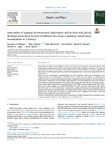2022-03-29Zeitschriftenartikel
Association of regional socioeconomic deprivation and rurality with global developmental delay in early childhood: Data from mandatory school entry examinations in Germany
Hoffmann, Stephanie
Tschorn, Mira
Michalski, Niels
Hoebel, Jens
Förstner, Bernd R.
Rapp, Michael A.
Spallek, Jacob
Background:
From birth to young adulthood, health and development of young people are strongly linked to their living situation, including their family’s socioeconomic position (SEP) and living environment. The impact of regional characteristics on development in early childhood beyond family SEP has been rarely investigated. This study aimed to identify regional predictors of global developmental delay at school entry taking family SEP into consideration.
Method:
We used representative, population-based data from mandatory school entry examinations of the German federal state of Brandenburg in 2018/2019 with n=22,801 preschool children. By applying binary multilevel models, we hierarchically analyzed the effect of regional deprivation defined by the German Index of Socioeconomic Deprivation (GISD) and rurality operationalized as inverted population density of the children’s school district on global developmental delay (GDD) while adjusting for family SEP (low, medium and high).
Results:
Family SEP was significantly and strongly linked to GDD. Children with the highest family SEP showed a lower odds for GDD compared to a medium SEP (female: OR=4.26, male: OR=3.46) and low SEP (female: OR=16.58, male: OR=12.79). Furthermore, we discovered a smaller, but additional and independent effect of regional socioeconomic deprivation on GDD, with a higher odds for children from a more deprived school district (female: OR=1.35, male: OR=1.20). However, rurality did not show a significant link to GDD in preschool children beyond family SEP and regional deprivation.
Conclusion:
Family SEP and regional deprivation are risk factors for child development and of particular interest to promote health of children in early childhood and over the life course.
Dateien zu dieser Publikation

